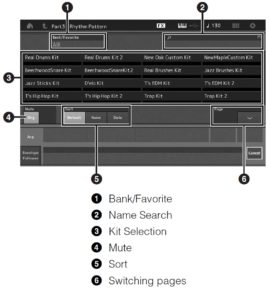I’m going to update this page as information rolls out.
The Yamaha MODX Owner’s Manual is now available in the Yamaha manual library. No Data List PDF (yet). Once we have the Data List, we’ll be able to do a better comparison of effect types versus the Montage. Yamaha added a number of effect algorithms through updates and, of course, we’re hoping that the MODX will have the same arsenal.
After taking a quick side-by-side pass through the MODX Owner’s Manual, it’s clear that the MODX has much of the on-screen Montage user interface. The MODX and Montage code base is now the same and this should help Yamaha to swat bugs on both platforms and to reduce internal software development costs.
New to the MODX user interface are Rhythm Patterns. Quoting the MODX Owner’s Manual:
The [Rhythm Pattern] button provides a simple way to add a rhythm part to the current Performance. By combining rhythm patterns and the Envelope Follower, you can modify the patterns even further.
Use this button to call up the Rhythm Pattern display. You select the Rhythm Pattern you want to use, and then press [PERFORMANCE (HOME)] button or [EXIT] button to set the selection.
Seems to be a way to get a beat going quickly and is an enhancement of the existing arpeggio mechanism. [Click image to enlarge.]
Rest assured. There is a performance recorder/sequencer which is the (nearly) the same as Montage (MODX: 128 songs, Montage: 64 songs). Lack of a full sequencer (a la Motif/MOX) will disappoint some. I intend to keep my MOX6 and trusty QY-70.
The on-screen Live Set operation is identical to Montage. As noted before, the MODX drops the extensive bank of front panel buttons on the Montage. The Montage’s physical buttons mirrored the operation of the Live Set on-screen buttons, etc. I’ll have to try switching patches on-the-fly using the touch screen alone to determine if this is an acceptable compromise for me. I rely on quick changes when I play and I don’t always know in advance what voice I’ll be using. I’m an improvisational orchestrator.
Also as noted earlier, there are four sliders instead of eight. Front panel buttons select between part group 1 to 4 and group 5 to 8 in order to control part volume via the sliders. Again, some operational compromises due to cost saving as there are fewer direct access controls on the MODX. The MODX also has fewer SHIFT functions due to the elimination of the Montage’s front panel button matrix.
On-line retailers are beginning to offer the MODX on pre-order. Yamaha is going to sell a lot of these!
USA pricing table:
| MODX6 | MODX7 | MODX8 | |
|---|---|---|---|
| MSRP (list) | $1,649 USD | $1,899 USD | $2,399 USD |
| MAP (street) | $1,299 USD | $1,499 USD | $1,899 USD |
| Weight | 14.6 pounds | 16.3 pounds | 30.4 pounds |
Yamaha MODX vs. Montage table:
| Feature | MODX | Montage |
|---|---|---|
| Display | 7″ WVGA color TFT | 7″ WVGA color TFT |
| AWM2 poly | 128 | 128 |
| FM-X poly | 64 | 128 |
| SSS | 4 parts | 8 parts |
| Faders | 4 | 8 |
| Encoders | 4 | 8 |
| Buttons | 4 | 8 |
| Ribbon | No | Yes |
| USB audio in | 4 channels (2 stereo) | 6 channels (3 stereo) |
| USB audio out | 10 channels (5 stereo) | 16 channels |
| Sampling frequency | 44.1kHz | Up to 192kHz |
| ADC inputs | 2 | 2 |
| Dual insert effects | 12 parts+A/D | 16 parts+A/D |
| Waveforms | 6,347 | 6,347 |
| Waveform ROM | 5.67GB | 5.67GB |
| Flash ROM | 1.00GB | 1.75GB |
| User Performances | 640 | 640 |
| Library Performances | 5,120 | 5,120 |
| Scenes | 8 per Perf | |
| Arpeggios | 10,239 | 10,000+ |
| Simultaneous Arps | 8 | 8 |
| Perf Rec Songs | 128 | 64 |
| MIDI | IN,OUT | IN,OUT,THRU |
| Output | Unbalanced | Balanced |
| Keyboard | Synth | FSX |
| Aftertouch | No | Yes |
| Weight 61-key | 14.6 pounds | 33.1 pounds |
Copyright © 2018 Paul J. Drongowski

